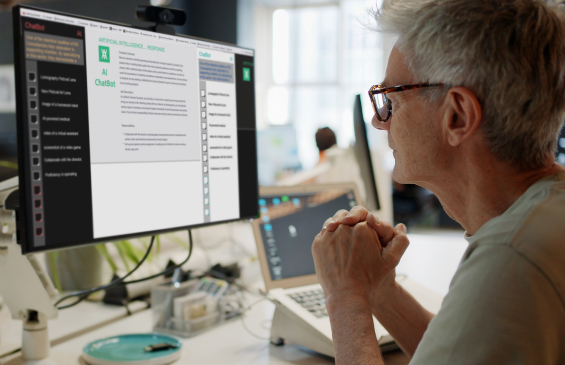Navigating Misinformation and Deepfakes in the AI Era: What PR Professionals Need to Know

July 30, 2025
Public Relations today is about more than press releases and media coverage — it’s about navigating trust, ethics, and misinformation in an AI-driven world. From deepfakes to viral falsehoods, today’s PR professionals face challenges that demand both strategic thinking and technical awareness. In 2023, over 40 percent of Canadians thought it was becoming harder to distinguish between true and false news or information, compared with three years prior, according to Statistics Canada.
Whether you’re thinking about PR as a career or already working in the field, having a strong foundation in media ethics, crisis response, strategic storytelling, and campaign planning provides you with the framework to thrive in this constantly changing media landscape.
We sat down with a seasoned PR professional to explore how the role is changing and why now is the perfect time to develop foundational and future-ready communication skills. Randy Phipps, Founder and Principal of RP Communications, was a guest speaker at the “Building Connections as a Public Relations Professional” panel discussion at The Chang School earlier this year.
Strategic Communications Matter
Now more than ever, it is essential for PR professionals to be not only reactive but also strategic, proactive, and deeply informed. Even though AI has replaced some of the more laborious tasks in the PR workflow like scanning media coverage and personalizing messaging across audiences, there’s no replacement for human insight.
Randy points out that many tools PR professionals already use now come with built-in AI features, helping to save time by automating repetitive tasks and speeding up research. In terms of managing information, AI scans and analyzes huge amounts of data and information in real time so it can stay on top of trends, track media coverage, and catch potential issues early, as well as better tailor messages by segmenting audiences, personalizing pitches, and getting content to the right audience faster.
While that allows them to focus more on being strategic, AI isn’t replacing the human side of PR anytime soon. “AI doesn’t replace the human side of PR,” says Randy. “Things like emotional nuance, timing, and cultural sensitivity still need that personal or human touch. AI can help us work smarter, but the strategy, creativity, and relationships are still where we come in.”
Don’t Rush to React: Smart Responses to Misinformation
Being smart about when to respond to misinformation is also part of being strategic. When confronted with a piece of information, the first thing to do is to go straight to the source and consult a reputable expert.
“We work with a lot of trusted professionals, and when misinformation comes up, they’re often able to quickly spot what’s false and provide accurate information that helps us respond with confidence,” says Randy.
However, he adds that it’s crucial to assess the situation before reacting.
“Not every piece of misinformation warrants a public response. Sometimes addressing it can unintentionally amplify it, which is known as the ‘Streisand effect’,” says Randy. (The Streisand effect is the phenomenon where attempting to hide or censor information online inadvertently draws more attention to it, making it more widely publicized than it would have been otherwise. It's named after American singer Barbra Streisand, who, in 2003, tried to suppress a photograph of her Malibu mansion, resulting in the image becoming widely known.)
That said, a quick response is critical when misinformation poses a real threat to your brand.
“Then, it’s important to act,” says Randy. “First, pinpoint where it originated, figure out whether it stemmed from a lack of clarity, a misunderstanding, or something more serious, and respond in a way that’s thoughtful and transparent.”
Randy adds that it’s also important to reflect internally to make sure that if misinformation is gaining traction because of internal issues, like unclear messaging or something that actually needs fixing, it’s important to get to the root of the problem so it doesn’t happen again.
What’s Real and What’s (Deep)Fake?
One of the main ways that AI technology is used to misinform the public is through deepfakes, which in recent years have come to wield massive influence in media and security. Deepfakes are synthetic media, usually video or audio, created by AI models to mimic real people’s faces, voices, or movements with eerie realism. There are countless examples of deepfakes, including attempts to interfere with elections, such as in January 2024 when a deepfake robocall of President Joe Biden encouraged Democrats not to vote in a New Hampshire primary.
Randy says that’s why media scanning is more important than ever.
“As PR professionals, we need to be constantly monitoring the media landscape every day,” he says. “Having systems in place to track what’s being said about your brand helps you catch potential issues early, before they have a chance to spread.”
As with all misinformation, the same rule applies here to be strategic and calm. “If you catch something early, flag it internally, verify it with your team or experts, and take steps to have it corrected and removed quickly and quietly,” says Randy.
But, if the content starts gaining traction and threatens your brand’s reputation, then that’s the time to take a more visible stand, he adds. “Issue a clear, confident statement that lets your audience know this content is false, it doesn’t reflect your values, and, most importantly, direct people to your official channels where they can find accurate information.”
The Right Tools – and the Right Mindset
Staying on top of misinformation requires what Randy calls “ears to the ground” tools. These include real-time media monitoring tools like Meltwater, Cision, and free options like Google Alerts, which can track mentions of a brand, keywords, or competitors.
“They’re great for spotting misinformation early, especially when something starts gaining momentum online,” says Randy, adding that critical thinking and fact-checking are crucial skills a PR professional needs to possess.
“You need to know how to vet sources quickly by asking questions like, ‘Where is this coming from?’, ‘Is it credible?’, and ‘Can it be verified?’”
Lastly, Randy says maintaining strong relationships with subject matter experts is key – if something questionable pops up, being able to call on a trusted expert to help clarify or confirm the facts can save valuable time and protect a brand before things get out of hand.
Whether you're just starting out or advancing your PR career, combining hands-on experience with the right education helps you stay ahead in a fast-changing media landscape. Having structured, formal training in PR, like that provided in the Certificate in Public Relations offered at The Chang School, provides a clearer, more reliable understanding of how PR works.

